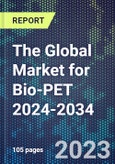1 EXECUTIVE SUMMARY
1.1 Market drivers and trends in bioplastics and biopolymers
1.2 Global production to 2034
1.3 Main producers and global production capacities
1.3.1 Producers
1.3.2 By biobased and biodegradable plastics type
1.3.3 By region
1.4 Global demand for Biobased and Biodegradable Plastics (Bioplastics), by market
1.5 Challenges for the Biobased and Biodegradable Plastics (Bioplastics) market
1.6 The Global bio-PET market
3 THE GLOBAL PLASTICS MARKET
3.1 Global production of plastics
3.2 The importance of plastic
3.3 Issues with plastics use
3.4 Policy and regulations
3.5 The circular economy
3.6 Conventional polymer materials used in packaging
3.6.1 Polyolefins: Polypropylene and polyethylene
3.6.2 PET and other polyester polymers
3.6.3 Renewable and bio-based polymers for packaging
3.7 Comparison of synthetic fossil-based and bio-based polymers
3.8 End-of-life treatment of bioplastics
4 THE GLOBAL BIOPLASTICS MARKET
4.1 Bio-based or renewable plastics
4.1.1 Drop-in bio-based plastics
4.1.2 Novel bio-based plastics
4.2 Biodegradable and compostable plastics
4.2.1 Biodegradability
4.2.2 Compostability
4.3 Advantages and disadvantages
4.4 Types of Bio-based and/or Biodegradable Plastics
5 THE GLOBAL BIO-PET MARKET
5.1 Market overview
5.1.1 Currently available bio-PET
5.1.2 100% bio-PET
5.2 Comparative analysis
5.3 Supply landscape and trends
5.4 Market supply chain
5.5 SWOT analysis
5.6 Market drivers
5.7 Market challenges
5.8 Regulations
5.9 Producers and production capacities
5.9.1 bio-PET production capacities, by country
5.10 Demand for bio-PET 2019-2034 (1,000 tons)
5.10.1 Demand by market
5.10.2 Demand by region
5.10.2.1 North America
5.10.2.2 Europe
5.10.2.3 Asia-Pacific
5.10.2.4 South America
5.11 PET biorecycling
5.12 Pricing
5.13 Markets for Bio-PET
5.13.1 Packaging
5.13.1.1 Flexible packaging
5.13.1.2 Rigid packaging
5.13.2 Consumer goods
5.13.3 Automotive
5.13.4 Textiles
5.13.5 Films & sheets
List of Tables
Table 1. Market trends and drivers in biobased and biodegradable plastics (bioplastics).
Table 2. Global production capacities of biobased and biodegradable plastics 2018-2034, in 1,000 tons.
Table 3. Global production capacities for biobased and biodegradable plastics (bioplastics), by producers.
Table 4. Global production capacities of biobased and biodegradable plastics (bioplastics) 2019-2033, by type, in 1,000 tons.
Table 5. Issues related to the use of plastics.
Table 6. Types of biobased and biodegradable plastics (bioplastics).
Table 7. Comparison of synthetic fossil-based and bio-based polymers.
Table 8. Biodegradability of bioplastics in different environments.
Table 9. Type of biodegradation.
Table 10. Advantages and disadvantages of biobased plastics compared to conventional plastics.
Table 11. Types of Bio-based and/or Biodegradable Plastics, applications.
Table 12. Bio-based Polyethylene terephthalate (bio-PET) market analysis- manufacture, advantages, disadvantages and applications.
Table 13. Comparative analysis with PET.
Table 14. Comparative analysis with other bio-based plastics.
Table 15. Market supply chain for bio-PET.
Table 16. SWOT analysis: bio-PET market.
Table 17. Market drivers for bio-PET.
Table 18. Market challenges for bio-PET.
Table 19. Key regulations related to bio-based PET (polyethylene terephthalate) plastic.
Table 20. Bio-based Polyethylene terephthalate (PET) producers and production capacities,
Table 21. Global Bio-PET demand 2019-2034, by market (1,000 tons).
Table 22. Global Bio-PET demand 2019-2034, by region (1,000 tons).
Table 23. Biobased and sustainable plastics producers in Europe.
Table 24. Current pricing and future pricing forecast for bio-PET.
Table 25. Processes for bioplastics in packaging.
Table 26. Comparison of bioplastics’ (PLA and PHAs) properties to other common polymers used in product packaging.
Table 27. Typical applications for bioplastics in flexible packaging.
Table 28. Typical applications for bioplastics in rigid packaging.
List of Figures
Figure 1. Total global production capacities for biobased and biodegradable plastics, all types, 000 tons.
Figure 2. Global production capacities of biobased and biodegradable plastics (bioplastics) 2018-2033, in 1,000 tons by biodegradable/non-biodegradable types.
Figure 3. Global production capacities of biobased and biodegradable plastics (bioplastics) in 2019-2033, by type, in 1,000 tons.
Figure 4. Global production capacities of biobased and biodegradable plastics (bioplastics) 2019-2033, by region, in 1,000 tons.
Figure 5. Current and future applications of biobased and biodegradable plastics (bioplastics).
Figure 6. Global demand for biobased and biodegradable plastics (bioplastics) by end user market, 2021
Figure 7. Global production capacities for biobased and biodegradable plastics (bioplastics) by end user market 2019-2033, 1,000 tons.
Figure 8. Challenges for the biobased and biodegradable plastics (bioplastics) market.
Figure 9. Global plastics production 1950-2020, millions of tons.
Figure 10. The circular plastic economy.
Figure 11. Routes for synthesizing polymers from fossil-based and bio-based resources.
Figure 12. Coca-Cola PlantBottle®.
Figure 13. Interrelationship between conventional, bio-based and biodegradable plastics.
Figure 14. Bioplastics regional production capacities, 1,000 tons, 2019-2033.
Figure 15. Bio-based Polyethylene terephthalate (Bio-PET) production capacities, 1,000 tons, 2019-2033
Figure 16. Global Bio-PET demand 2019-2034 (1,000 tons).
Figure 17. Global Bio-PET demand 2019-2034, by market (1,000 tons).
Figure 18. Global Bio-PET demand 2019-2034, by region (1,000 tons).
Figure 19. Bio-PET demand 2019-2034, in North America (1,000 tons).
Figure 20. Bio-PET demand 2019-2034, in Europe (1,000 tons).
Figure 21. Bio-PET demand 2019-2034, in Asia-Pacific (1,000 tons).
Figure 22. Bio-PET demand 2019-2034, in South America (1,000 tons).
Figure 23. Good Natured Products Inc. bio-PET packaging.
Figure 24. Global production capacities for biobased and biodegradable plastics in consumer products 2019-2033, in 1,000 tons.
Figure 25. CuanSave film.
Figure 26. Teijin bioplastic film for door handles.









